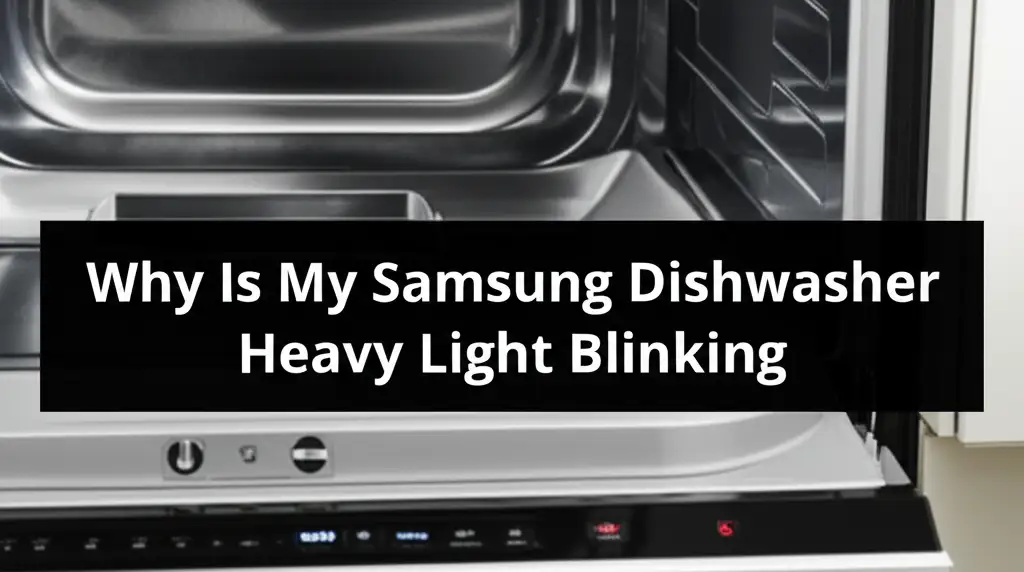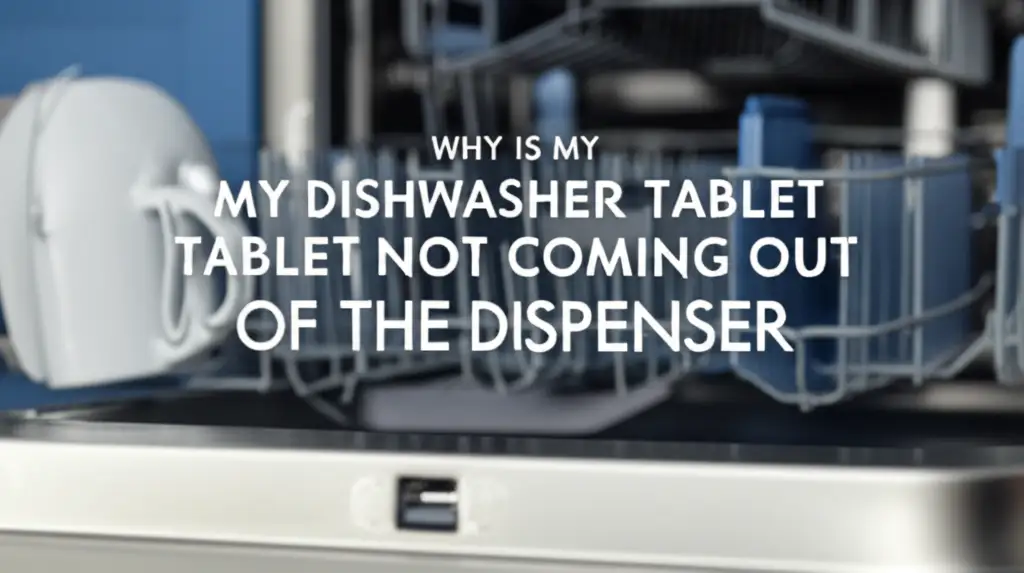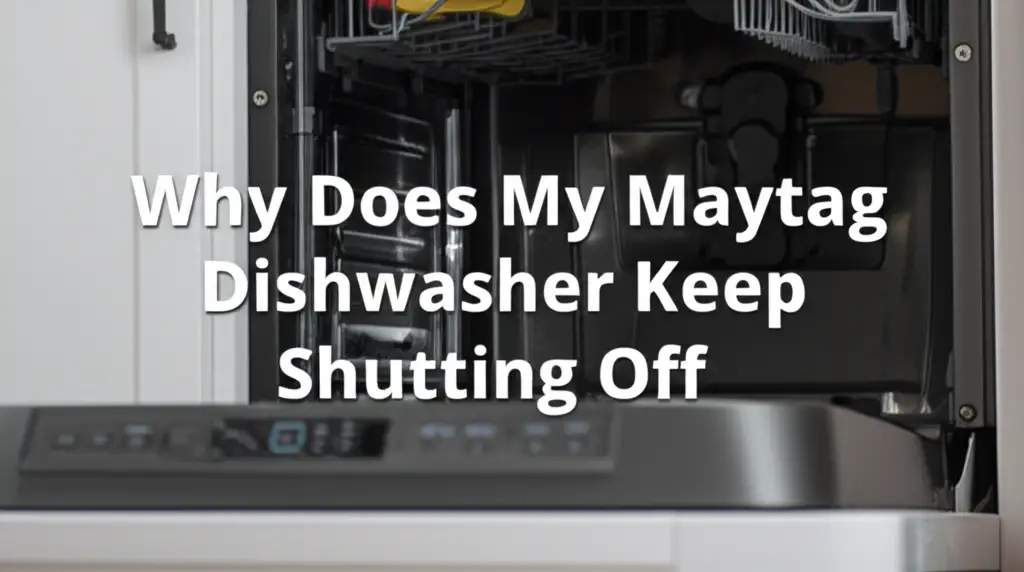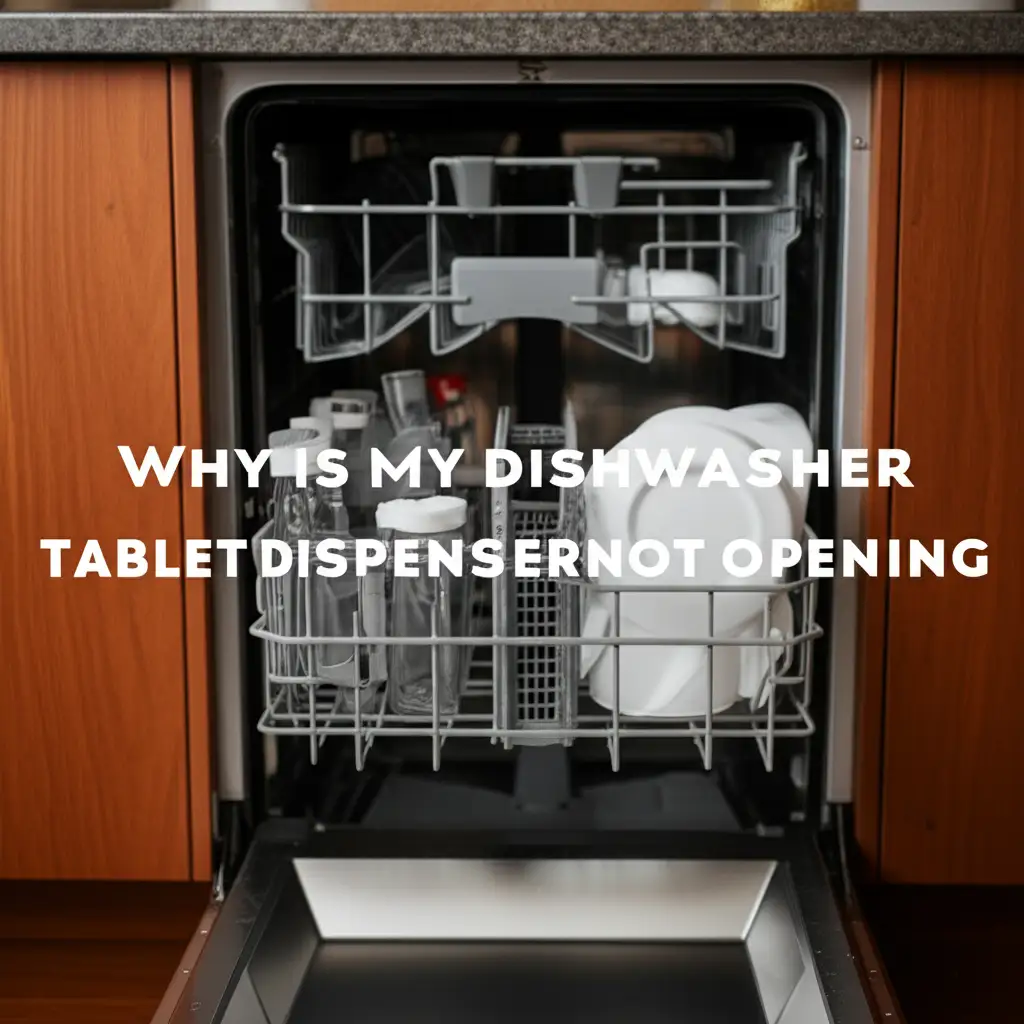· Katria Melrose · Samsung Appliances · 20 min read
Why Is My Samsung Dishwasher Heavy Light Blinking

Samsung Dishwasher Heavy Light Blinking: What It Means
A blinking light on any appliance can feel frustrating. When your Samsung dishwasher’s “Heavy” light starts blinking, it signals an issue. This light usually indicates a problem that prevents a normal cycle. You need to understand what this blinking means. Ignoring it can lead to more serious dishwasher problems.
I remember the first time my Samsung dishwasher’s Heavy light started blinking. It stopped mid-cycle, leaving dishes dirty. This article will help you understand common reasons for this blinking light. We will cover simple troubleshooting steps you can perform. You will learn to identify the issue and fix it, saving you time and money. Let’s get your dishwasher working properly again.
Takeaway
- The “Heavy” light blinking often indicates a water-related issue or a system fault.
- Check water supply, drain hose, and internal filters first.
- Resetting the dishwasher can clear minor glitches.
- Sensor or control board issues might require professional help.
Why Your Samsung Dishwasher’s Heavy Light Blinks
When your Samsung dishwasher’s “Heavy” light blinks, it often signals an interruption in the wash cycle due to an error. This can relate to water not filling, draining incorrectly, or a sensor problem. The dishwasher detects a fault and stops operation. It blinks the light to alert you.
Understanding Your Samsung Dishwasher’s Heavy Cycle Light
Your Samsung dishwasher has several indicator lights. Each light provides information about the machine’s status. The “Heavy” cycle light typically glows when you select the heavy-duty wash option. This setting is for heavily soiled pots and pans. It uses more water and a longer wash time. When this light blinks, it usually signals an error code. The dishwasher cannot complete the chosen cycle.
This blinking acts as a diagnostic warning. It tells you something is wrong. You might notice the dishwasher did not start. Perhaps it stopped mid-cycle. The blinking “Heavy” light points to an internal problem. It is the machine’s way of asking for attention. Understanding this signal is the first step toward a fix. You need to check a few things before calling a technician.
Samsung dishwashers are smart machines. They use sensors to monitor water levels, temperature, and more. When one of these sensors detects an abnormality, it triggers an error. This error often manifests as a blinking light. The “Heavy” light blinking might mean insufficient water. It could also point to a drainage problem. Sometimes, it means a more complex electrical issue. We will explore each possibility. Knowing the potential causes helps you troubleshoot effectively.
A solid “Heavy” light indicates the cycle is active. A blinking light signals a fault condition. It tells you the dishwasher stopped functioning as expected. My own dishwasher once had a blinking light. I found out it was a simple issue with the water supply. It is important not to panic. Most problems have straightforward solutions. We will walk through them step by step.
Why Your Samsung Dishwasher Heavy Light Blinks: Common Causes
Several issues can cause your Samsung dishwasher’s “Heavy” light to blink. These range from simple user errors to more complex component failures. Understanding these common causes helps you pinpoint the problem quickly. The most frequent culprits involve water flow, drainage, and internal sensors. Your dishwasher needs proper water pressure to fill. It also needs a clear path to drain water. Any disruption in these processes can trigger an error.
One common reason is a problem with the water supply. The dishwasher might not receive enough water. This prevents it from starting or continuing a cycle. A closed water valve or a kinked hose can cause this. Another frequent issue is drainage. If water cannot drain properly, the dishwasher stops. This can happen due to a clogged filter or drain hose. Sometimes, the issue is not mechanical but electrical. A glitch in the control board can lead to blinking lights.
Sensor malfunctions are also a possibility. Samsung dishwashers use sensors to monitor water levels and cleanliness. A faulty sensor can send incorrect signals to the control board. This makes the dishwasher think there is an error, even if there isn’t. Overloading the dishwasher can also cause issues. Too many dishes can block spray arms or interfere with water circulation. This can lead to an incomplete wash and a blinking light. Detergent problems are less common but can occur. Too much or too little detergent might confuse the machine.
Sometimes, the blinking light is a general error code. It might mean the dishwasher cannot complete any cycle. This general fault often points to water fill or drain issues. Let’s look at each of these common causes in detail. We will cover how to diagnose and fix them. You can often resolve these issues without calling a professional.
Water Supply Issues
Insufficient water supply is a primary reason for a blinking “Heavy” light. The dishwasher needs a steady flow of water to operate. It checks water levels during the cycle. If the level is too low, it stops and signals an error.
- Check the Water Inlet Valve: Locate the water inlet valve behind your dishwasher. Ensure it is fully open. Sometimes, it gets partially closed. This restricts water flow.
- Inspect the Water Supply Hose: Look for kinks or bends in the hose. A kinked hose blocks water. Straighten any kinks you find. Also, check for damage to the hose. A damaged hose might not supply water efficiently.
- Verify Water Pressure: Ensure your home’s water pressure is adequate. Low household water pressure affects the dishwasher. You can test this by running a faucet nearby. If the faucet runs slowly, your overall water pressure might be low.
Drainage Problems
If your dishwasher cannot drain water, it will stop the cycle. The blinking “Heavy” light can indicate a drainage issue. Water remaining in the tub is a clear sign.
- Clean the Dishwasher Filter: Your Samsung dishwasher has a filter at the bottom. Food particles and debris collect here. A clogged filter prevents proper drainage. Refer to your owner’s manual to find and clean the filter. This is a common maintenance task. Learn where the filter is in a Samsung dishwasher.
- Inspect the Drain Hose: The drain hose connects the dishwasher to your sink’s drain or garbage disposal. Check for clogs inside the hose. Food debris can accumulate over time. Ensure the hose is not kinked or bent. Kinks restrict water flow.
- Check the Air Gap (if applicable): Some installations include an air gap on the sink. This device prevents drain water from flowing back into the dishwasher. It can get clogged. Remove the cap and clean any debris from the air gap.
Sensor and Control Panel Issues
Modern dishwashers rely on sensors. They also rely on a control panel. Problems with these components can cause blinking lights.
- Water Level Sensor: This sensor detects the water level in the tub. If it malfunctions, the dishwasher might think there is no water. It will stop filling and signal an error. Cleaning the sensor might help. Sometimes, it needs replacement.
- Leakage Sensor: Samsung dishwashers often have a sensor on the bottom tray. This sensor detects leaks. If it gets wet, even from condensation, it can trigger an error. Check for water in the drip tray. Dry it thoroughly if you find any.
- Control Panel Reset: A quick reset can clear minor glitches. Turn off power to the dishwasher at the circuit breaker. Wait for a few minutes. Then, turn the power back on. This is like rebooting a computer. It can resolve temporary errors. If your Samsung dishwasher is blinking and not starting, a reset is often the first step. Find more information on why your Samsung dishwasher is blinking and not starting.
Diagnosing Water Supply Issues for Blinking Heavy Light
When your Samsung dishwasher’s “Heavy” light blinks, water supply is often the first suspect. The dishwasher needs a specific amount of water to run a cycle. If it does not get this water, it stops and indicates an error. I have seen this issue many times. It is usually a simple fix.
First, check the water valve. This valve controls water flow to the dishwasher. It is typically under the sink or behind the dishwasher. Make sure the valve is fully open. If it is only partially open, water flow will be weak. This can cause the dishwasher to register an error. Turn the valve clockwise to close it, then counter-clockwise to open it completely.
Next, inspect the water inlet hose. This hose connects the water supply to your dishwasher. Look for any kinks or bends. A kink in the hose restricts water flow. Straighten any kinks you find. Also, feel along the hose for any signs of damage. A damaged hose might leak or have internal blockages. If the hose looks damaged, it might need replacement.
Another point to check is the water pressure. Your home’s overall water pressure affects the dishwasher. If your house has low water pressure, the dishwasher might not fill quickly enough. You can test water pressure by turning on a nearby faucet. If the water flow is weak, contact a plumber to check your home’s main water supply. Ensure nothing else uses a lot of water at the same time. This can temporarily reduce pressure.
The water inlet screen can also get clogged. This small screen is inside the water inlet valve connection on the dishwasher. It filters out debris from the water supply. Over time, mineral deposits or dirt can build up here. Turn off the water supply before disconnecting the hose. Use pliers to pull out the screen. Clean it with an old toothbrush. Reassemble everything carefully. This simple cleaning often resolves water supply issues.
Lastly, consider the water inlet valve itself. This valve controls water entry into the dishwasher. If it is faulty, it might not open fully or at all. You can test it with a multimeter if you are comfortable. However, replacing this part usually requires a professional. Before you decide it is faulty, rule out all other simpler causes. A blinking “Heavy” light due to water issues is often easily fixed by checking these components.
Troubleshooting Drainage Problems in Samsung Dishwashers
Drainage problems are common culprits for a blinking “Heavy” light on your Samsung dishwasher. If the dishwasher cannot drain water properly, it will stop the cycle. Water might remain in the tub after a cycle. This is a clear sign of a drainage issue. I have faced this exact problem before. It is usually due to clogs.
The first place to check is the dishwasher filter. This filter sits at the bottom of the dishwasher tub. It catches food particles and debris. Over time, it gets clogged with food scraps and grease. A clogged filter severely impacts drainage. To clean it, first remove the lower dish rack. Twist or unclip the filter assembly. Remove any visible debris. Rinse the filter under running water. Use a brush to scrub away stubborn residue. Reinstall the filter securely. Cleaning this filter regularly is good practice. For detailed instructions, see where the filter is in your Samsung dishwasher.
Next, inspect the drain hose. This hose carries dirty water from the dishwasher to your sink drain or garbage disposal. Check for kinks or bends along its entire length. A kinked hose will prevent water from flowing freely. Straighten any kinks you find. Also, look for blockages inside the hose. Disconnect the hose from both ends if you suspect a clog. You might need to use a snake or a stiff wire to clear it. Be careful not to damage the hose.
If your dishwasher drains into a garbage disposal, check the disposal itself. Food debris can back up into the dishwasher drain hose. Run the garbage disposal for a minute or two. Make sure it is clear. Also, if you recently installed a new garbage disposal, ensure the knockout plug was removed. This plug blocks the dishwasher drain connection. Forgetting to remove it is a common mistake.
Some dishwasher installations include an air gap. This small cylinder is on your sink countertop. It prevents drain water from re-entering the dishwasher. An air gap can become clogged with debris. Remove the chrome cap and plastic cover. Clean out any food particles or grime you find inside. A clogged air gap will prevent proper drainage.
Finally, consider the drain pump. This motor pumps water out of the dishwasher. If it is faulty, water will not drain. You might hear buzzing sounds, or no sound at all from the pump. Testing or replacing a drain pump is more involved. It might require professional help. Rule out the simpler clogs first. Most drainage issues are resolved by cleaning the filter or clearing a hose.
Addressing Sensor Malfunctions and Control Panel Glitches
Sensor malfunctions and control panel glitches can cause your Samsung dishwasher’s “Heavy” light to blink. These issues are less common than water supply or drainage problems. However, they can still prevent your dishwasher from running. Understanding how these components work helps in troubleshooting.
Samsung dishwashers use various sensors. The water level sensor is crucial. It tells the dishwasher how much water is in the tub. If this sensor is dirty or faulty, it might give false readings. The dishwasher could think there is no water, even if the tub is full. This causes it to stop filling or halt the cycle. Cleaning the sensor might help. Locate it, usually at the bottom of the tub or near the inlet. Use a soft brush to remove any residue. If cleaning does not work, the sensor may need replacement.
Another important sensor is the leakage sensor. This sensor is located in a pan beneath the dishwasher. Its purpose is to detect water leaks. If water collects in this pan, the sensor trips. It then sends a signal to the control board, stopping the dishwasher. This prevents flood damage. Sometimes, a small amount of condensation or a minor spill can trigger it. Check the pan under the dishwasher for water. Dry it completely if you find any. Make sure there are no actual leaks from hoses or connections.
The control panel itself can experience glitches. This panel houses the buttons and display. It is the brain of your dishwasher. Electrical surges or minor power fluctuations can cause it to behave erratically. A blinking “Heavy” light might simply be a software bug. A simple reset can often fix this. To reset your Samsung dishwasher, turn off the power at the circuit breaker. Wait about 5-10 minutes. Then, turn the power back on. This clears the control board’s memory. It can resolve temporary errors. Many users find this simple step surprisingly effective. If your Samsung dishwasher is blinking and not starting, a control panel reset is a good first step. You can find more solutions if your Samsung dishwasher is blinking and not starting here.
Sometimes, the control panel buttons themselves stick or malfunction. This can send continuous signals to the main board. Check if any buttons are stuck in the pushed-in position. Gently try to unstick them. If the control panel is unresponsive or shows erratic behavior after a reset, it might be faulty. Replacing a control board is complex. It often requires a professional technician. Always rule out simpler issues before considering this expensive repair.
Overloading and Detergent Issues Affecting the Heavy Light
The way you load your Samsung dishwasher and the type of detergent you use can also cause the “Heavy” light to blink. These issues often lead to inefficient cleaning. The dishwasher might then stop the cycle. It will indicate an error through the blinking light. I’ve learned from experience that proper loading is key.
Overloading is a common problem. We all want to fit as many dishes as possible. However, cramming too many items into the dishwasher is counterproductive. Too many dishes can block the spray arms. Water and detergent cannot reach all surfaces. This results in dirty dishes. More importantly, it interferes with water circulation. The dishwasher’s sensors might detect improper water flow or pressure. This can trigger an error and make the “Heavy” light blink. Always leave enough space between dishes. Ensure the spray arms can spin freely. Run a cycle without dishes to test this.
Using the wrong type or amount of detergent can also cause issues. Dishwashers require specific dishwasher detergent. Using liquid dish soap creates too many suds. Excessive suds can overflow the dishwasher. They can also confuse the water level sensor. This can lead to a blinking error light. Always use automatic dishwasher detergent. Read the detergent instructions carefully for the correct amount. Too much detergent can leave a residue on dishes. Too little might not clean properly.
Detergent pods or tablets are convenient. Ensure they fully dissolve during the wash cycle. If a pod does not dissolve, it means the dishwasher is not getting the cleaning power it needs. This might be due to water temperature or a dispenser issue. The “Heavy” light might blink if the cleaning performance is severely impacted. Check your detergent dispenser. Make sure it opens fully. Ensure no obstructions prevent the detergent from releasing into the wash tub.
Hard water can also affect detergent performance. Mineral deposits from hard water can build up. They can coat sensors and spray arms. This can lead to inefficient cleaning and sensor errors. If you have hard water, consider using a rinse aid. Rinse aid helps water sheet off dishes. It also prevents spots and film. Understanding why the rinse aid light is on your dishwasher can also be helpful. Some detergents include hard water softeners.
In summary, proper loading ensures water circulation. Using the correct detergent prevents sudsing or poor cleaning. These simple user practices significantly impact your dishwasher’s performance. They can prevent the “Heavy” light from blinking due to operational faults. Adjust your loading and detergent use. See if the blinking light resolves.
Advanced Troubleshooting and When to Call a Professional
If you have tried all the basic troubleshooting steps, and your Samsung dishwasher’s “Heavy” light still blinks, it might indicate a more complex problem. At this point, you are moving into advanced diagnostics. This often involves checking internal components. This type of work can be risky without proper knowledge. Knowing when to call a professional is important.
One area for advanced checking is the main control board. This board is the central processing unit of your dishwasher. It controls all functions. If the control board malfunctions, it can send incorrect signals. It might register false errors or fail to operate components. A blinking “Heavy” light could be a symptom of a failing board. You might notice other erratic behaviors too. The dishwasher might turn on by itself, or programs might not respond. If your Samsung dishwasher is turning on by itself, it might indicate a control board issue. Inspecting the control board for burnt spots or loose connections requires technical expertise. Replacing it is often expensive.
The wash motor or circulation pump could also be at fault. If these components fail, water will not circulate properly. This directly impacts the wash cycle. The “Heavy” light might blink because the dishwasher cannot achieve proper water pressure. You might hear unusual noises, or no noise at all, from the pump. Testing these components involves electrical checks. This should only be done by someone with experience.
Wiring issues are another possibility. Loose or damaged wires can disrupt communication between components. This can lead to intermittent errors. Inspecting wiring harnesses is challenging. It often requires disassembling parts of the dishwasher. Look for frayed wires or signs of burning. Always disconnect power before touching any wiring.
Error codes can provide more specific clues. While the “Heavy” light might blink, Samsung dishwashers often have a way to display more detailed error codes. Check your owner’s manual for how to access these diagnostic codes. They usually appear on the digital display. These codes pinpoint the exact component or system that is malfunctioning. For example, a code like “OE” might mean an overflow error, while “LE” might indicate a leakage error. Understanding these codes helps in further diagnosis.
When should you call a professional? If you have performed the basic checks and the issue persists, it is time to call. This includes:
- No Obvious Solution: You have checked water supply, drainage, filters, and performed a reset, but the light still blinks.
- Complex Internal Parts: The problem seems to be with a sensor you cannot access, the main control board, or the wash motor.
- Electrical Work: Any repair involving internal wiring or electrical components should be handled by a certified technician.
- Lack of Tools or Expertise: You do not have the right tools or feel uncomfortable disassembling your dishwasher.
A professional appliance technician has the training and tools to diagnose and repair these complex issues safely. They can accurately identify the faulty part. They can replace it without causing further damage. Investing in a professional repair can extend your dishwasher’s life. It ensures it runs safely and efficiently.
FAQ Section
Why does my Samsung dishwasher’s Heavy light blink constantly?
A constantly blinking “Heavy” light usually indicates an unresolved error. It often points to issues with water intake, drainage, or an internal sensor malfunction. The dishwasher stops operation when it detects this fault. Try resetting the dishwasher first. Check your water supply and drain lines.
Can a clogged filter cause the Heavy light to blink?
Yes, absolutely. A clogged filter at the bottom of your Samsung dishwasher is a common cause. Food debris can block drainage. This prevents the dishwasher from completing its cycle. It then signals an error with the blinking “Heavy” light. Clean the filter regularly to avoid this issue.
Is the blinking Heavy light a specific error code?
The blinking “Heavy” light itself is not a specific error code like “LE” or “OE”. It generally indicates a general operational fault or cycle interruption. Some Samsung models might show a more specific error code on the digital display alongside the blinking light. Always check your manual for specific error code interpretations.
How do I reset my Samsung dishwasher to stop the blinking light?
To reset your Samsung dishwasher, turn off the power at its circuit breaker. Wait for about 5 to 10 minutes. Then, turn the power back on. This hard reset can clear minor glitches in the control board. It often resolves temporary blinking light issues.
What should I do if the Heavy light blinks after I reset it?
If the “Heavy” light continues to blink after a reset, the underlying issue persists. Recheck your water supply. Ensure the drain hose is clear. Confirm no water is pooling under the dishwasher. If these steps do not help, the problem might be a faulty sensor or control board. Consider professional help at this point.
Can overloading my dishwasher cause the Heavy light to blink?
Yes, overloading your Samsung dishwasher can cause the “Heavy” light to blink. Too many dishes can block the spray arms. This prevents proper water circulation. The dishwasher’s sensors may detect inefficient cleaning or improper water flow. This can trigger an error and halt the cycle.
Conclusion
A blinking “Heavy” light on your Samsung dishwasher indicates an issue. Do not worry. This common problem often has a simple solution. We have explored the main reasons for this blinking. These include water supply problems, drainage issues, and sensor malfunctions. Overloading your dishwasher or using the wrong detergent can also cause it.
You can often fix these problems yourself. Start by checking the water inlet valve and hose. Make sure your dishwasher filter and drain hose are clear of clogs. Perform a quick reset of your control panel. These steps resolve many common issues. I encourage you to try these fixes before calling a professional. You might save time and money.
If the “Heavy” light still blinks after your efforts, consider advanced troubleshooting. This may involve checking the main control board or other internal components. For complex issues, electrical problems, or if you feel unsure, it is best to consult a certified appliance technician. They have the expertise to diagnose and repair complex faults safely.
By understanding what the Samsung dishwasher Heavy light blinking means, you can take control. You can troubleshoot effectively. Keep your Samsung dishwasher running smoothly and efficiently. Your dishes will be clean once again.
- Samsung dishwasher error
- blinking heavy light
- dishwasher repair
- appliance troubleshooting
- Samsung appliance issues
- dishwasher problems





